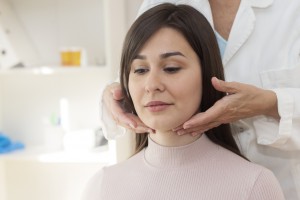Women and Thyroid Disease
 According to the US Department of Health and Human Services, women are more likely to develop thyroid disease than men. The risk for women increases right after a pregnancy and following menopause. One in eight women will be diagnosed with thyroid problems during their lifetime.
According to the US Department of Health and Human Services, women are more likely to develop thyroid disease than men. The risk for women increases right after a pregnancy and following menopause. One in eight women will be diagnosed with thyroid problems during their lifetime.
The thyroid is part of the endocrine system. It’s a butterfly shaped gland located in front of the neck. The thyroid produces a hormone that controls the body’s metabolism rate. The thyroid can affect a woman’s weight, heart rate, cholesterol levels, and menstrual cycles.
Hypothyroidism, or underactive thyroid, is one type of thyroid disease. If the thyroid is not producing enough thyroid hormones, the metabolism slows down. Some symptoms of hypothyroidism include weight gain, tiredness, joint or muscle pain, dry skin and hair, depression, and slow heart rate. Hashimoto’s disease is the most common cause of hypothyroidism. Treatment includes taking manufactured forms of thyroid hormone.
Hyperthyroidism is another type of thyroid disease. The thyroid becomes overactive, producing too much thyroid hormone. Symptoms can include weight loss, irregular heartbeat, trouble sleeping, lighter menstrual periods, increased sweating, and trembling in the fingers and hands. Treatments may include medications, radioiodine, or surgery to remove part or all of the thyroid gland. Graves’ disease is the most common cause of hyperthyroidism.
A thyroid nodule is a swelling or growth that can develop on the thyroid gland. There may be one or more nodules that can be solid or filled with fluid. Ultrasound tests can be used to evaluate nodules. Most nodules are not cancerous, so the doctor may just decide to watch and wait. If the nodule is large or cancerous, it may be surgically removed. Women are three times more likely than men to develop thyroid cancer.
September is thyroid cancer awareness month. When found early, thyroid cancer is usually treatable. A physician can perform a simple check of the thyroid gland during a routine physical examination.




